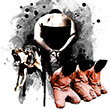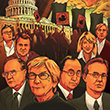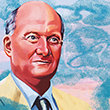
In their anxiety to keep their failures explained while they ask congresses, parliaments and legislatures for more millions to put in their pockets, psychiatry continually redefines key words relating to the mind.
Their “diseases” have become entirely different diseases over the last quarter of a century—and none of them have come any closer to being cured.
The German, Kraepelin, had a scale of mental diseases that became so long and involved (once said to number 1,500), and on which there was so little agreement, that it was largely abandoned.
Freud had a number of “mental diseases,” but these terms are not in extensive use today.
What is amazing is the psychiatric tendency to try to describe rather than to cure.
Schizophrenia and paranoia seem to be the modern favorite terms. But paranoia today becomes schizophrenia!
To these tangled terms today is added “incurable.” If one can’t cure something, the only way to maintain an authoritative pose about it is to say it can’t be cured. This also excuses absorbing all those funds with nothing to show. But if all these “diseases” are known to be incurable, then why spend money researching them?
The main point of all these tangled terms today is that anyone can be said to have some form of insanity just by saying a big word. As no one has agreed what the word means or what the symptoms are, this leaves the psychiatrist as an “authority.” In court and sanitarium, all he has to do is say, “Hm, er, hurumph, he’s a—ahem—borderline catatonic with—er—ahem—symptoms of paranoia—hm, hurumph.”
It sounds so impressive, and the fact he is about to be disabled for life so frightening to the person in question, that even jurisprudence is swayed. And some poor guy is sent to a living hell.
Confidence tricksters, bamboozlers, flimflam artists and psychiatrists have all mastered the same tricks. To say long words impressively is three-quarters of the game in “taking a mark.”
At least one world dictionary, unable to find psychiatric texts to quote, uses phrases from the New York Times and from the New Yorker magazine to define psychiatric terms. Maybe it is or isn’t intentional, but the New Yorker is world-renowned as a humor magazine.
Lord Dunsany’s famous story about the day the temple fell is a wonderful example. Somebody walked into the temple one day and pulled back the curtain on the holy of holies, the all-powerful and mysterious shrine that overawed the world. There was nothing there!
That is what is happening to psychiatry today. The outpoured government millions bought no cures, but only a lot of tangled terms and how they were all incurable.
When the curtain was pulled back, all that was behind it was PRO, public relations brag, and an empty hole.
If society wants insanity handled as a social problem, don’t go to the boys who have increased the insanity statistics for a century and who have only tangled terms to show for it. Go get the people who know what they are doing—the Scientologists.























